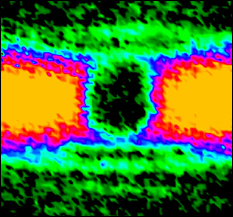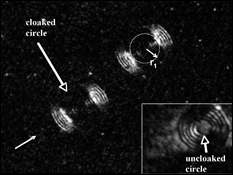Clark School Researchers Develop Two-Dimensional Invisibility Cloak |
|
FOR IMMEDIATE RELEASE CONTACT: Ted Knight Missy Corley A research team at Maryland's A. James Clark School of Engineering comprised of Professor Christopher Davis, Research Scientist Igor Smolyaninov, and graduate student Yu-Ju Hung, has used plasmon technology to create the world's first invisibility cloak for visible light. The engineers have applied the same technology to build a revolutionary superlens microscope that allows scientists to see details of previously undetectable nanoscale objects.
The invisibility cloak device is a two-dimensional pattern of concentric rings created in a thin, transparent acrylic plastic layer on a gold film. The plastic and gold each have different refractive properties. The structured plastic on gold in different areas of the cloak creates "negative refraction" effects, which bend plasmons—electron waves generated when light strikes a metallic surface under precise circumstances—around the cloaked region. This manipulation causes the plasmon waves to appear to have moved in a straight line. In reality they have been guided around the cloak much as water in a stream flows around a rock, and released on the other side, concealing the cloak and the object inside from visible light. The invisibility that this phenomenon creates is not absolutely perfect because of energy loss in the gold film. The team achieved this invisibility under very specialized conditions. The researchers' cloak is just 10 micrometers in diameter; by comparison, a human hair is between 50 to 100 micrometers wide. Also, the cloak uses a limited range of the visible spectrum, in two dimensions. It would be a significant challenge to extend the cloak to three dimensions because researchers would need to control light waves both magnetically and electronically to steer them around the hidden object. The technology initially may work only for small objects of specific controlled shape. The team also has used plasmonics to develop superlens microscopy technology, which can be integrated into a conventional optical microscope to view nanoscale details of objects that were previously undetectable. The superlens microscope could one day image living cells, viruses, proteins, DNA molecules, and other samples, operating much like a point-and-shoot camera. This new technology could revolutionize the capability to view nanoscale objects at a crucial stage of their development. The team believes they can improve the resolution of their microscope images down to about 10 nanometers—one ten thousandth of the width of a human hair. A large reason for the success of the group's innovations in both invisibility and microscopy is that surface plasmons have very short wave lengths, and can therefore move data around using much smaller-scale guiding structures than in existing devices. These small, rapid waves are generated at optical frequencies, and can transport large amounts of data. The group also has made use of the unique properties of metamaterials, artificially structured composites that help control electromagnetic waves in unusual ways using plasmonic phenomena. The diverse applications the group has derived from their plasmonics research is an example of the ingenuity of researchers approaching new and dynamic technologies that offer broad and unprecedented capabilities. The research has attracted a great deal of attention within the scientific community, industry and government agencies. Related plasmonics research offers applications for military and computer chip technologies, which could benefit from the higher frequencies and rapid data transfer rates that plasmons offer. The team's research has been funded by the National Science Foundation and Clark School Corporate Partner BAE Systems. Smolyaninov and Davis have published an article in the journal Science about their superlens microscope technology, titled "Magnifying Superlens in the Visible Frequency Range." The group and their colleagues from Purdue University will also soon publish a paper about their invisibility cloak research. About the A. James Clark School of Engineering The Clark School's graduate programs are collectively the fastest rising in the nation. In U.S. News & World Report's annual rating of graduate programs, the school is 16th among public and private programs nationally, 10th among public programs nationally and first among public programs in the mid-Atlantic region. The School offers 13 graduate programs and 12 undergraduate programs, including degree and certification programs tailored for working professionals. The school is home to one of the most vibrant research programs in the country. With major emphasis in key areas such as communications and networking, nanotechnology, bioengineering, reliability engineering, project management, intelligent transportation systems and space robotics, as well as electronic packaging and smart small systems and materials, the Clark School is leading the way toward the next generations of engineering advances. Visit the Clark School homepage at www.eng.umd.edu. ###
|
|
||||||||



 COLLEGE PARK, Md.—Harry Potter may not have talked much about plasmonics in J. K. Rowling's fantasy series, but University of Maryland researchers are using this emerging technology to develop an invisibility cloak that exists beyond the world of bespectacled teenage wizards.
COLLEGE PARK, Md.—Harry Potter may not have talked much about plasmonics in J. K. Rowling's fantasy series, but University of Maryland researchers are using this emerging technology to develop an invisibility cloak that exists beyond the world of bespectacled teenage wizards. Generally speaking, when we see an object, we see the visible light that strikes the object and is reflected. The Clark School team's invisibility cloak refracts (or bends) the light that strikes it, so that the light moves around and past the cloak, reflecting nothing, leaving the cloak and its contents "invisible."
Generally speaking, when we see an object, we see the visible light that strikes the object and is reflected. The Clark School team's invisibility cloak refracts (or bends) the light that strikes it, so that the light moves around and past the cloak, reflecting nothing, leaving the cloak and its contents "invisible."